Hanyangdoseong|
World Heritage and Hanyangdoseong

- Hanyangdoseong, Seoul City Wall [Historic Site]
- The wall, which follows the ridges of Baegak (Bugaksan), Naksan (Naktasan), Namsan (Mongmyeoksan) and Inwangsan, the four main mountains surrounding the center of Seoul, has been constantly managed since its initial construction in 1396. The wall measures between 5 and 8m high and is 18.6km long, and it bears witness to the role played by a city wall in the life of a capital city, still sustained in modern day Seoul.
- Hanyangdoseong has four main gates and four auxiliary gates. The main gates are Heunginjimun, Donuimun, Sungnyemun and Sukjeongmun, while the auxiliary gates are Hyehwamun, Souimun, Gwanghuimun and Changuimun. In addition, the five-arched water gate and two-arched water gate to the south of Heunginjimun were built to transport water from Cheonggyecheon Stream to outside the wall.
-
- Korean history is engraved in Hanyangdoseong.
-
Korean history is engraved in Hanyangdoseong. The wall preserves a succession of building technics and structure developed by the Korean people from the Three Kingdoms period onwards. It also shows the whole process of building-technic development during Joseon.
Hanyangdoseong was originally built about 620 years ago. The actual construction work continued for 98 days, half in the winter and half in the summer of 1394. Some 197,400 people were mobilized for the construction of the wall, which was divided into 97 sections with each measuring around 600 feet (approximately 180m). The sections were named in the order of the characters in the Thousand Character Classic. Workers from same counties and prefectures were assigned to a specific section. Originally, wall sections on flat ground were built of rammed earth, while those on mountainous terrain were built of stone. However, in 1422, the earthen sections of the wall were replaced with stone as well. In 1704, another massive restoration and rebuilding project was carried out, as parts of the wall had collapsed over the course of time. And since then several restorations have been carried out, too. During the construction of the wall, records of the works were inscribed on the stone blocks of the wall.
Hanyangdoseong lost a large part of its former appearance during the country’s modernization. In 1899, the first tram lines were built to connect Seoul with outlying communities, and the wall gates lost their original function. Thereafter, the wall connected to the gates were demolished for the expansion of the city’s road networks from 1907. In the Japanese colonial period, Japanese governors deliberately dismantled the wall gates or neglected to be damaged. Donuimun and Souimun Gate were dismantled and Gwanghuimun and Hyehwamun Gate were seriously damaged. Also the wall was damaged in that local residents built their houses too near to it. After Korean liberation from Japan, the wall continued to be damaged in the rush of modernization.
Conservation of Hanyangdoseong began at a site around Sukjeongmun Gate, behind Presidential residence, shortly after a unit of North Korean Special Forces infiltrated Seoul on 21 January 1968. That project was extended to the entire wall section from 1974. However, the authenticity of Hanyangdoseong was damaged in places as conservation and restoration works were overly focused on rejoining severed sections. Seoul Metropolitan Government fully recognized these problems, and established the department exclusively responsible for the wall, Hanyangdoseong Division in September 2012. And the city government drew up master plan for the conservation and management of Hanyangdoseong in accordance with the criteria for UNESCO World Heritage Sites in October 2013.
As of 2022, some 78% (14.5km) of entire Hanyangdoseong has been kept in tact, and Sukjeongmun, Gwanghuimun, and Hyehwamun went through conservation work, although Gwanghuimun and Hyehwamun had to be put on locations near their original sites.
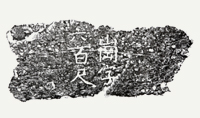 [A stone block of the wall, inscribed as “Gangjayukbaekcheok”]
[A stone block of the wall, inscribed as “Gangjayukbaekcheok”]
A Stone of the wall, written as “Gangjayukbaekcheok” was discovered in an embankment near the Namsan J-Gran House. The stone block is the record of the constructon section and length. The original position of this stone is unknown, as the embankment was built with the stones acquired from the demolished wall.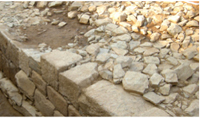 [Excavation site of Hanyangdoseong at the foot of Hoehyeon, Namsan]
[Excavation site of Hanyangdoseong at the foot of Hoehyeon, Namsan]
In 2013, a section of the wall(94.1m), which had been demolished in 1925 (during the Japanese Colonial Period) to build the Joseon Shinto Shrine was excavated. This section of the wall, built with both original stone blocks from the wall and new stone blocks used for its repair, shows the layers of 600-years history of the wall. -
- Hanyangdoseong, which protected Seoul for some 600 years, closely affected the daily life of the people inside.
-
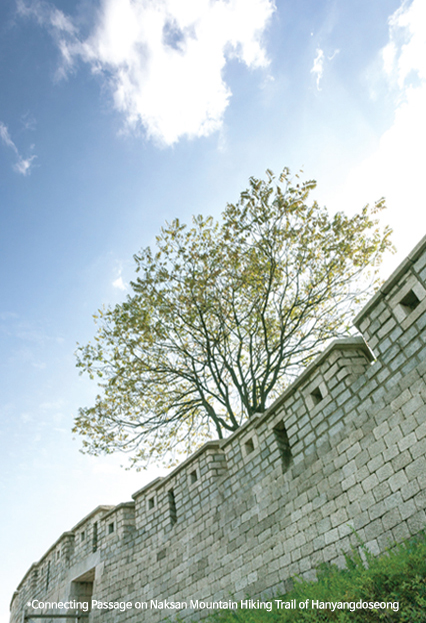 Hanyangdoseong, which protected Seoul for some 600 years, closely affected the daily life of the people inside. Residents were informed of the opening and closing times of the city gates by the sound of the Bell at Bosingak Belfry on Jongno. The bell was struck thirty-three times to lift the curfew in the early morning and twenty-eight times to announce the curfew in the evening. The gates of private houses were opened and closed according to the tolling of the bell, so the opening and closing times of the city gates controlled the rhythm of the citizen’s life.
Hanyangdoseong, which protected Seoul for some 600 years, closely affected the daily life of the people inside. Residents were informed of the opening and closing times of the city gates by the sound of the Bell at Bosingak Belfry on Jongno. The bell was struck thirty-three times to lift the curfew in the early morning and twenty-eight times to announce the curfew in the evening. The gates of private houses were opened and closed according to the tolling of the bell, so the opening and closing times of the city gates controlled the rhythm of the citizen’s life.
Hanyangdoseong was also a boundary between life and death. Everyone who died, whether king or commoner, had to be buried outside the wall. Thus, living within the wall signified life itself to the people in Seoul.
Hanyangdoseong represented the capital itself. People headed towards the capital from countryside would see the wall in the distance and realized they were nearing their destination. The wall meant something different to the scholars who traveled to the capital to take the state examinations, success in which would land them a government post. Some of those candidates, hoping to pass the exam, would walk around the entire wall. This practice became popular among local residents and developed into a traditional amusement going around the wall and enjoying the beautiful scenery.
Hanyangdoseong helped unite the capital with its suburbs. Quarrying was prohibited inside the wall, stones used for the wall had to be supplied from outside. Although the wall was built on the ridges of Mts. Baegak, Naksan, Namsan(Mongmyeoksan) and Inwangsan, the stone materials came from areas around Mts. Bukhansan and Achasan outside the wall.
The capital protection system was anchored by Hanyangdoseong. The wall alone was insufficient for defending the capital. during times of external invasion or civil rebellion, the wall was never used for the purpose of defense. Therefore, people commonly complained about all the work to build the wall in that is useless. On September 11, 1971 in lunar calender, King Yeongjo proclaimed the decree on guarding the walls, declaring, “In an emergency, I will be the first to go up to the fortified wall to defend the city with the people.” Moreover, the king assigned each defense section to a community inside the wall so that they could protect their own section with their own weapons in event of an emergency.
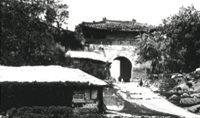 [Hyehwamun Gate]
[Hyehwamun Gate]
Hyehwamun from outside the wall. Hyehwamun served as a passageway to city of Uijeongbu and Pocheon from the capital.
* Old Photo of Hyehwamun Gate | National Museum of Korea Collection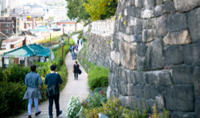 [Naksan Mountain Trail]
[Naksan Mountain Trail]
As the administrative district of Seoul has expanded greatly, Hanyangdoseong, which once marked the boundary between Hanseongbu (Capital Prefecture in Joseon) and its outskirts 600 years ago, has now become a cultural property in the center of Seoul. -
- Hanyangdoseong is the outcome of a succession of developments regarding the structure and the techniques used to construct fortress walls on both mountainous terrain and flat ground since Goguryeo.
- Hanyangdoseong pairs royal palaces and fortress walls of Bukhansanseong and Namhansanseong, which protected the capital city. The shape of the stone blocks and inscriptions on them indicate the construction date and time period.
-
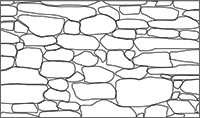 The wall construction in the reign of King Taejo (1396)
The wall construction in the reign of King Taejo (1396)
The wall were completed by two separate projects in January and August of 1396(lunar calender). The stone sections of the wall were built on mountainous terrain, while rammed earth sections were constructed on flat ground. Natural stones were shaped for use in the construction of the wall.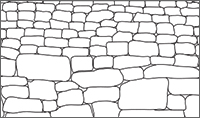 The wall construction in the reign of King Sejong (1422)
The wall construction in the reign of King Sejong (1422)
The wall reconstruction project in January of 1422(lunar calender) replaced the rammed earth sections with natural stones chiseled into kernel shape.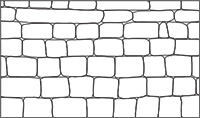 The wall construction in the reign of King Sukjong (1704~)
The wall construction in the reign of King Sukjong (1704~)
The stone blocks used in the rebuilding of the wall were made in a standardized size of 40~45cm in length and width, preserving the wall more solid than before.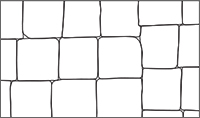 The wall construction in the reign of King Sunjo (1800~)
The wall construction in the reign of King Sunjo (1800~)
Square(60cm x 60cm)stone blocks were used to construct the wall. Stone blocks with character engravings can be seen along the parapet. Research into the inscriptions is ongoing.
-
Hanyangdoseong was built along the natural topography around Seoul. Respect for nature is a long-held tradition of the Korean people. Thus, the wall, which was built in this natural way, became a part of the natural environment over time and a subject of culture and art.
Hanyangdoseong is one of the world’s longest and oldest city walls. It is rare to find city walls the size of Hanyangdoseong in any city with a population of ten million people or more. Although some sections are damaged, 78% of the entire length of the wall has been preserved or rebuilt.
Hanyangdoseong was registered on UNESCO’s World Heritage Tentative List on 23 November 2012. Getting Hanyangdoseong listed as a UNESCO World Heritage Site is an expression of the Korean people’s desire and resolution to preserve the natural and historical landscape of Seoul and to hand it down to future generations. The most important factor in preserving any cultural heritage is the love by the residents who live with that cultural heritage.




